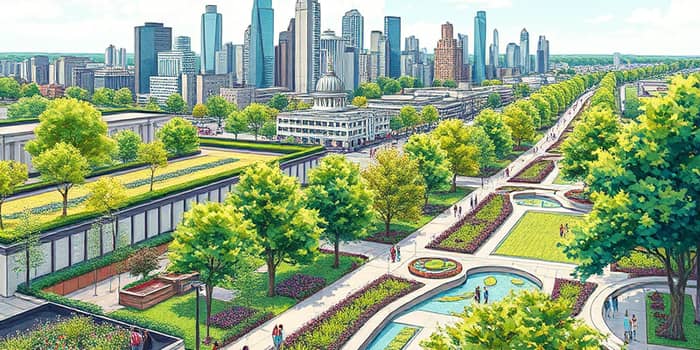
Green infrastructure represents a transformative approach to urban planning that shifts the focus from grey, hardened systems to living, adaptable landscapes. As climate challenges intensify, cities around the world are recognizing the urgent need to embrace nature-based solutions.
By integrating natural systems into urban landscapes, we can create resilient neighbourhoods that protect communities, enhance well-being, and deliver lasting economic value.
At its core, green infrastructure refers to strategically planned networks of parks, roofs, wetlands, and corridors that work in harmony with nature. Unlike conventional grey structures made of concrete and steel, these living systems harness ecological processes to address pressing urban challenges. When cities build with and around nature, they unlock a suite of benefits that strengthen communities and safeguard the environment.
Green infrastructure encompasses a wide variety of elements, from bioswales that intercept polluted runoff to vegetated green walls that filter air pollutants. Each component functions as part of a larger ecological network, illustrating the power of holistic urban planning.
From mitigating floods to cooling city streets, green infrastructure delivers a range of ecological services. Key benefits include:
Systems such as permeable pavements and bioswales capture and filter rainwater, easing the strain on outdated drainage networks. Rain gardens planted along sidewalks can divert excess water, reducing pollutant loads and preventing combined sewer overflows during storms. Green roofs not only retain rainwater but also provide insulation that lowers building energy use.
Welcoming native plants and trees back into cities promotes a thriving urban ecosystem where pollinators and birds can flourish. These habitats create stepping stones that connect wildlife populations, bolstering biodiversity even in densely built environments.
Access to vibrant green spaces strengthens both mind and body. Studies link proximity to parks with lowered stress levels, improved mood, and reduced rates of cardiovascular disease. Children who play in natural settings often exhibit higher levels of creativity and concentration.
Well-designed green infrastructure fosters stronger community bonds by creating inviting gathering places for neighbours, friends, and families. Whether it is a weekend farmers' market under a tree canopy or an outdoor classroom beside a restored wetland, these areas become social anchors that improve quality of life.
During heatwaves, parks and tree-lined streets can prevent loss of life by offering relief from soaring temperatures. Incorporating water features such as bioswales or constructed wetlands into these spaces adds an extra layer of resilience, reducing heat stress and improving public safety.
Access to nature has even been linked to reduced symptoms of anxiety and depression, highlighting the critical connection between nature and well-being. As cities grow denser, preserving and expanding these green oases becomes ever more important.
Successful green infrastructure projects share several core principles that ensure adaptability and maximum benefit:
By following these guidelines, planners and designers can create projects that deliver immediate gains and remain effective for decades. Adaptive management, which involves monitoring performance and making incremental adjustments, further increases long-term success.
Turning vision into reality requires aligning policy, funding, and community engagement:
Innovative financing models, such as green bonds and stormwater fees, can generate dedicated revenue streams. Technology also plays a vital role: remote sensing and data analytics help track vegetation health, measure temperature reductions, and quantify stormwater capture in real time.
Community-led initiatives, such as neighbourhood tree planting and volunteer stewardship groups, foster a sense of ownership and ensure the long-term care of green infrastructure assets.
Investments in green infrastructure yield substantial returns. By lowering energy consumption, improving public health, and increasing property values, cities can see payback periods as short as five years. Landscaped parks and tree-lined streets often make neighbourhoods more desirable, boosting local commerce and tax revenues.
Governments at all levels benefit from reduced healthcare costs and minimized expenses for grey infrastructure maintenance. As the frequency of extreme weather events rises, the protective services provided by GI—in particular flood control and heat mitigation—become increasingly valuable.
Successful case studies, from Melbourne's "Grey to Green" program to urban canopy expansions in Seattle, demonstrate that systematic commitment and strong leadership can transform grey spaces into dynamic green landscapes over time.
Green infrastructure is more than a technical solution; it is a shared vision for healthier, more equitable cities. By weaving nature into urban fabric, we not only protect ecosystems but also create spaces that unite communities, invigorate economies, and nurture well-being.
Every stakeholder has a role to play—city officials can adopt robust policies, designers can champion creative solutions, businesses can invest in sustainable developments, and residents can advocate for pocket parks and street trees. Together, we can cultivate cities that thrive in the face of climate change and continue to inspire future generations.
Embrace the green infrastructure movement and become a steward of the urban environment. The time is now to build resilient portfolios, vibrant neighbourhoods, and cities where people and nature flourish side by side.
References





